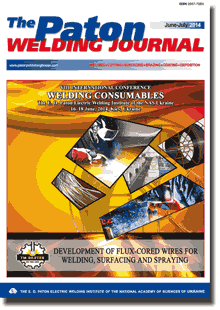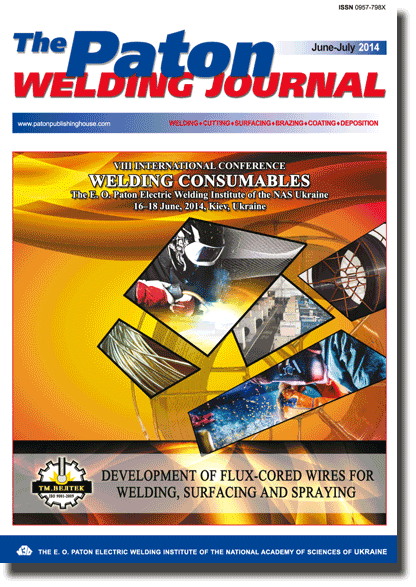Access for download PDF files for subscribers and for reviewers of scientometric bases.
Organization: Elsevier for content access(PDF files of journals released before 2024 are available for download from the website's archives))
Organization: Elsevier for content access(PDF files of journals released before 2024 are available for download from the website's archives))
| 2014 №06 (32) |
DOI of Article 10.15407/tpwj2014.06.33 |
2014 №06 (34) |

The Paton Welding Journal, 2014, #6-7, 151-154 pages
ULTRAVIOLET RADIATION IN MANUAL ARC WELDING USING COVERED ELECTRODES
O.G. LEVCHENKO1, A.T. MALAKHOV1 and A.Yu. ARLAMOV2
1E.O. Paton Electric Welding Institute, NASU. 11 Bozhenko Str., 03680, Kiev, Ukraine. E-mail: office@paton.kiev.ua
2NTTU «Kiev Polytechnic Institute». 37 Pobedy Ave., 03056, Kiev, Ukraine
Abstract
Welding arc is the source of intensive flow of optic radiation in infrared, visible and ultraviolet (UV) ranges, among which the most severe UV-C radiation with a strong harmful effect on the human organs of vision and skin covering should be distinguished. The aim of this work consisted in complex investigation of integral characteristics of UV radiation covered-electrode in manual arc welding (MAW), with covered electrodes of different grades (MR-3, UONI-13/55, ANO-12, ANO-36) and types of coatings (rutile, basic, rutile-cellulose), designed for welding of carbon and low-alloyed steels. The intensity of UV-C and UV-A radiation was measured using dosimeter of optic radiation DAU-81 at the distances of 0.55-1.50 m from the spot of welding. It was established during analysis and statistic processing of measurement results that at this distance at, which usually welder and support personnel are staying during MAW, the integral intensity of UV-C radiation amounts to 0.7-5 W/m2, which 700-5000 times exceeds the standard value of 0.001 W/m2 specified by the acting sanitary standards SN 4557-88 for workers with non-protected skin surfaces. Here the minimum distance, at which staying of the mentioned category of workers at direct visibility of welding place is admissible, amounts from 25 to 65 m (depending on the grade of electrode and value of welding current). Intensity of UV-C radiation depends, in the first turn, on the grade of applied electrodes but not on the type of their coating. It was shown that the intensity of UV radiation is inversely proportional to the square of distance from welding arc and greatly depends on welding current. The results of this work can be used in sanitary-hygienic certification of working stations of welders. 6 Ref., 4 Tables.
Keywords: ultraviolet radiation, integral characteristics, safe distance, manual arc welding, covered electrodes
Received: 09.04.14
Published: 28.09.14
References
1. Okuno, T, Ojima, J., Saito, H. (2001) Ultraviolet radiation emitted by CO2 arc welding. Annals Occup. Hygience, 45(7), 597-601. https://doi.org/10.1093/annhyg/45.7.597
2. Magnus, Ya.R., Katyshev, P.K., Peresetsky, A.A. (1998) Econometrics: Basic training. Moscow: Delo.
3. Schwass, D., Witllich, M., Shmitz, M. et al. (2011) Emission of UV radiation during arc welding. www. dguv.de/ifa. 1-12
4. SN 4557-88: Sanitary norms of ultraviolet radiation in production premises. Introd. 23.02.1988. Moscow: Minzdrav SSSR.
5. Directive 2006/25/EC of the European Parliament and of the Council of 5 April 2006 on the minimum health and safety requirements regarding the exposure on workers to risks arising from physical agents (artificial optical radiation).
6. Terry, L. Lyon. (2002) Knowing the dangers of actinic ultraviolet emissions. Welding J., Dec., 28-30.
Suggested Citation
O.G. LEVCHENKO, A.T. MALAKHOV and A.Yu. ARLAMOV (2014) ULTRAVIOLET RADIATION IN MANUAL ARC WELDING USING COVERED ELECTRODES. The Paton Welding J., 06, 151-154.The cost of subscription/purchase order journals or individual articles
| Journal/Currency | Annual Set | 1 issue printed |
1 issue |
one article |
| TPWJ/USD | 384 $ | 32 $ | 26 $ | 13 $ |
| TPWJ/EUR | 348 € | 29 € | 24 € | 12 € |
| TPWJ/UAH | 7200 UAH | 600 UAH | 600 UAH | 280 UAH |
| AS/UAH | 1800 UAH | 300 UAH | 300 UAH | 150 UAH |
| AS/USD | 192 $ | 32 $ | 26 $ | 13 $ |
| AS/EUR | 180 € | 30 € | 25 € | 12 € |
| SEM/UAH | 1200 UAH | 300 UAH | 300 UAH | 150 UAH |
| SEM/USD | 128 $ | 32 $ | 26 $ | 13 $ |
| SEM/EUR | 120 € | 30 € | 25 € | 12 € |
| TDNK/UAH | 1200 UAH | 300 UAH | 300 UAH | 150 UAH |
| TDNK/USD | 128 $ | 32 $ | 26 $ | 13 $ |
| TDNK/EUR | 120 € | 30 € | 25 € | 15 € |
AS = «Automatic Welding» - 6 issues per year;
TPWJ = «PATON WELDING JOURNAL» - 12 issues per year;
SEM = «Electrometallurgy Today» - 4 issues per year;
TDNK = «Technical Diagnostics and Non-Destructive Testing» - 4 issues per year.


